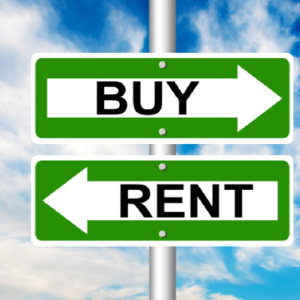Rent or Buy?
Riverbank Ruminations; Observations from The Banks of The Technology River
Tom Evans ~ Ashton Engineer Emeritus
 Rent or buy (or lease or buy) is a decision that people go through both personally and in business. One accountant I worked with provided this simple decision tree. If it depreciates, lease it. If it appreciates, buy it. That’s one way to look at it. Business needs may say everything should be purchased or everything should be leased. That’s a business decision. When it comes to personal accommodations, you may need to rent or lease because you don’t have the funds to purchase. Personal goals and desires will dictate whether renting is acceptable or even desirable.
Rent or buy (or lease or buy) is a decision that people go through both personally and in business. One accountant I worked with provided this simple decision tree. If it depreciates, lease it. If it appreciates, buy it. That’s one way to look at it. Business needs may say everything should be purchased or everything should be leased. That’s a business decision. When it comes to personal accommodations, you may need to rent or lease because you don’t have the funds to purchase. Personal goals and desires will dictate whether renting is acceptable or even desirable.
Pros and Cons
Sometimes manufacturers will take actions to force the decision, or at least make a great effort to influence consumers to go one way or the other. Microsoft, for example, makes it very obvious that they want you to rent software. Office 365 (Microsoft 365) or whatever the label of the day is, is a subscription model for software. The ‘benefit’ for the consumer is supposed to be the fact that you will always have the latest and greatest software, as long as you pay your bill.
The consequences of not paying a subscription have always been the same. At some point, whatever you are subscribing to becomes unavailable. If you are renting an apartment and you don’t pay your rent (at least pre-covid), the eventual result is eviction, your occupancy comes to an end. If you lease a car and you don’t make your payments, your driving ends with repossession. This is not a new business model and it is fairly well understood by most people.
Now that we are in an era of internet-connected things (IoT), there are some options available to vendors (lessors) that did not exist before. Let’s take vehicle repossession. If a vendor needed to repossess a vehicle, it had to be found. A ‘repo man’ needed to be found, sent on-site and the vehicle repossessed, possibly over the strenuous objection of the lessee. A lot of physical interaction could be involved in this action.
The Subscription Model
Let’s look at three different transactions that involve ‘subscriptions’. The first is Tivo. At various times, you had to pay for the program guide. The program guide is the heart of the functionality of the box for recording. When I bought my Tivo, the particular model came with a lifetime subscription to the program guide included. Other models did not. It appears that now, all models have the guide. The point is that a very important feature was a separate charge or not, at the whim of the vendor. Other vendors included or charged for a program guide with their product. It is software so the vendor can control it at their discretion.
Severe Consequences
The second is a motorcycle airbag vest. This article covers the issue. As far as I can tell there is no deception involved. You buy the vest and are told if you want it to function correctly you need to subscribe to a service that controls the function of the airbag feature. You can choose to pay a fixed amount and have the service activated. The monthly subscription plan was touted as useful for someone who did not ride all year. What happens if you forget to turn on the service and go riding? You don’t have an airbag. It would seem that the app (yes it needs an app) will warn you that the airbag is not functional. There is no chance someone would go riding under those circumstances, is there? Suppose your card is stolen, you get a new one and don’t update your service contract? Your payment will be declined and your vest stops working. There is a 30 day grace period. That surely is enough time for you to fix the problem and ride safely again, isn’t it? I find it hard to get excited about a life-saving product that can be remotely disabled. Not because they can do it if I don’t pay, but because they can do it remotely. Software never has bugs, does it? People never get account numbers wrong, do they?
The third example is Tesla. This article relates some issues with software components of physical assets. They mention how Tesla extended the range of their cars to assist drivers to escape a hurricane in Florida. That is commendable. It also “meant that what you bought could magically and secretly be changed without your permission or desire.” This takes a more sinister turn when you consider the times when this happened:
Tesla officially sold the car to the dealership on November 15, a date I’ve confirmed by seeing the car’s title. On November 18, Tesla seems to have conducted an ‘audit’ of the car remotely. The result of that audit was that when the car?s software was updated to the latest version in December, the Enhanced Autopilot and Full Self Driving Capability (FSD) were removed from the car.
The problem here is that the car was sold to the dealership and then a customer with the EA and FSD listed as being installed on the car. As the article says, “imagine If you buy, say, a used Ford Ecosport (not my first choice, but you do you) that has lane keeping assist and active cruise control, and Ford somehow thinks you didn’t pay for those particular features and sends over a service tech to physically remove them from your car, I think we’d all consider that pretty wrong.”
Understand What You’re Buying
There are many issues involved in these and other situations that involve products with software components. Some of the components are niceties, others are key to the function of the physical asset. Do you know which are which on products you own? The consequences of missing a payment can range from inconvenient to possibly fatal. The challenge for consumers is to make sure they understand what they are buying, how it works, and what happens if you miss a payment. Do you understand the vendor’s business model? Does it work for you? IoT (Internet of Things) seems to be here to stay. Make sure you can control and understand the ones you own.






